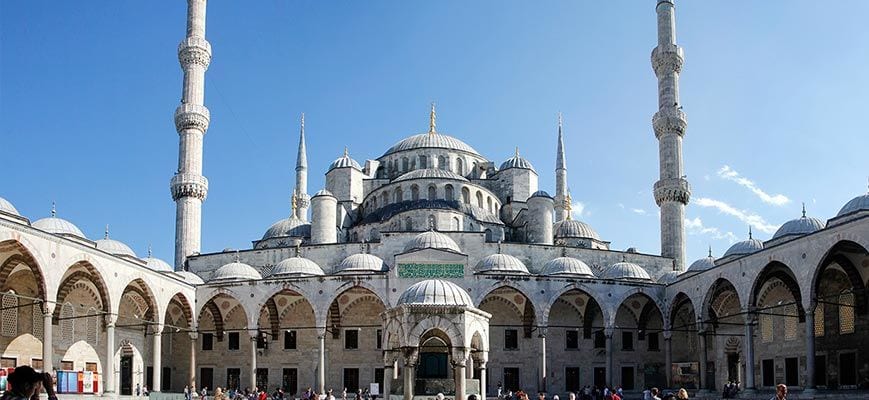No products in the cart.
Information
Sultanahmet Mosque (Blue Mosque) Information
The Mosque of Sultanahmet or Blue Mosque, is considered the most important, elegant and colorful of Istanbul. Built in the time of Sultan Ahmed I, between 1609 and 1616, it owes its nickname to the blue mosaics from Iznik (Nicea) that cover its walls and give it a unique atmosphere.
It is said that the project of Sultan Ahmet was to build a splendid mosque, which would surpass the colossal Hagia Sophia in size and beauty. With this purpose, he chose his location right in front of the old Byzantine basilica and next to the Hippodrome, in the same place where the Great Palace of the Byzantine Emperors was located, whose foundations and vaults were used. But to achieve his project, the Sultan would need large sums of money, which ended up misappropriating the treasure, a skill very badly received by his subjects.
The architect Sedefkar Mehmet Ağa, disciple of the great Sinan, was in charge of the constructive work. His book of the project and construction execution plan comprised eight volumes and today can be seen in the Tokpapi Palace library.
The Mosque of Sultanahmet combines the traditional style of Islamic architecture with some elements of Byzantine art, taken from its great referent Hagia Sophia.
In addition to its more than 20 thousand blue mosaics, other of the most outstanding elements in its interior are the so-called “elephant feet”, columns of 4.5 meters thick that serve as pillars to the multiple domes, and the mihrab (niche) ), made of finely carved and sculpted marble and an inscription panel on top. At his side, the very ornate minber, or pulpit, where magnets are placed to conduct the sermon. The Mosque of Sultanahmet is designed in such a way that from any point you can see and hear the magnet.
Inside the Mosque can be seen more than 200 windows of beautiful stained glass windows, although they are not the originals, as well as the incredible chandeliers that hang from the central dome, 33 meters wide. In the beginning, these lamps were covered with gold and precious pearls and some of them are displayed in museums. It is known that in the chandeliers ostrich eggs were used to scare the spiders, which although they are sacred creatures for the Muslims, they are not welcome in the religious constructions.
The Sultanahmet Mosque is the only one in Istanbul that has six minarets, which seems to have aroused some suspicion in the period of its construction, since such a display was supposed to be reserved exclusively for the Prophet’s Mosque in Mecca, so the Sultan Ottoman ended up paying for the construction of a seventh minaret for the sacred edification of Mecca.
According to urban legends, the six minarets of the Blue Mosque are due to a misunderstanding between the sultan and his architect, given when the former requested for his work altın minare (golden minarets) and the latter believed he understood altınare (six minarets).
On November 30, 2006, Pope Benedict XVI visited the Sultanahmet Mosque, which holds the only second papal visit to a place of Muslim worship.
Besides being one of the main tourist attractions of Istanbul, the Blue Mosque is an active religious center, so that five times a day the unbelieving public is closed for about half an hour, for prayer.
[tg_program title = “” place = “How to view the Blue Mosque? Suggestions”] To visit the Blue Mosque and any other mosque, it is best to do it mid-morning or in general, between prayer times. Avoid visits on Fridays, during the noon prayer, because it is usually much more crowded and extensive, so it will take longer to reopen the public.Before entering a mosque you must take off your shoes and place them in a plastic bag that they usually provide at the entrance. This routine is inviolable for Muslims.
If she is a woman, she must have her head and shoulders covered to enter the mosque. In case of not having any cover; They are offered at the entrance handkerchiefs and scarves, which will be used to cover their hair and shoulders. Do not cover your face.
The entrance to the Blue Mosque, from 9:00 a.m. to 7:00 p.m., is free.


